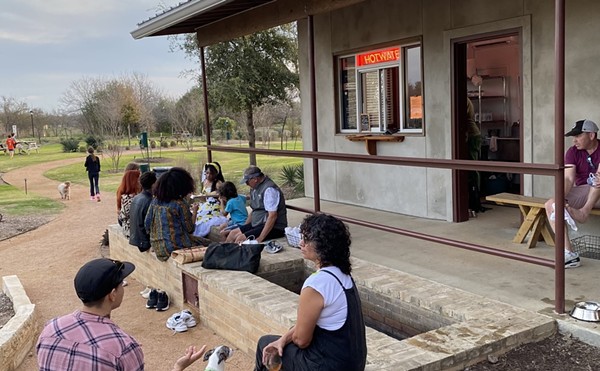“I can taste the Norman spices,” said my friend Ken, talking with his mouth full, minutes before he introduced us.
We were behind the canoe rack in an overgrown garden. Children were swarming a tamarind tree, chewing the fleshy, tart pods. Norman, sporting close-cropped hair, a puffy beard and a twinkle in his eye, relaxed on a picnic table. “Tamarind,” he said, watching the kids. “That’s the secret ingredient.”
Norman had cooked lunch for an outrigger canoe race that day, at the Keoua canoe club on Hawaii’s Big Island. The meal was a richly spiced assortment of squash, bean chili, tomato soup, salad, rice, and breadfruit. The tomato soup was especially amazing.
As we relaxed in the shade, a Fijian woman with an Aussie accent, a smile as big as the
Pacific, and a third place medal from the race that day poured fresh kava to drink. Good kava tastes like really good mud. Norman gave us a Ziploc bag with some brown powder inside. Not kava. It was the Norman spices; a dry-roasted, mixed, and crushed preparation he called rasam.
Rasam is a general term, like curry, or garam masala, and there are many regional variations in rasam recipes across South India. Rasam can also refer to a thin, sour soup spiced with rasam powder, usually eaten alongside a lentil-based vegetable mush called sambar.
According to legend, rasam soup was invented when a South Indian raja threw a big party, during which all of the sambar was consumed, leaving the cooks and servers devoid of anything to eat with their rice. Someone thought to combine all of the leftover ingredients from the sambar — the dal (lentil) water, leftover tamarind juice, and leftover tomatoes — and spiced it up. Thus, a new dish was born.
Today, sambar and rasam constitute the backbone of the South Indian diet. “It’s Brahman food,” Norman says, referring to the elevated priestly caste of Hindu religion.
Brahmans bring their holy ways into their kitchens, he explained. “Cooks of other castes might not do all of the rituals and say the mantras like the Brahmans. So Brahmans will only eat their own food. Members of any other caste will eat Brahman cooking, too, but might not eat each other’s. So Brahmans are the cooks as well as the priests. They are the ones cooking at railroad stations where they have to feed 10,000 to 20,000 travelers a day.”
Norman isn’t making this stuff up. He lived in India for a decade, earning a master’s degree and studying for a doctorate in Indology, or ancient Indian history and archeology, at the University of Mysore.
Rasam soup, he explained, has evolved into something of a power drink for Brahmans, taken twice daily.
“I was in India long enough to get my education and learn my philosophies and learn how to cook,” Norman said. When he returned to the states, he helped introduce a style of yoga known as Ashtanga, which incorporates movement with strength building and developed a wide following. A Google search of “Norman Allen Yoga” turns up about 50,000 hits.
After years traveling widely as a yoga teacher, Norman decided it was time to simplify his life and “drop out,” as he put it. With degrees in geography and education (from before his studies in India) as well as his Indology degree, Norman might be the most educated dropout in most places – although perhaps not Hawaii.
“I just want to do my little thing,” he says. “Teach my yoga class, cook at the canoe club, paddle the boats, raise my kids, work my farm.” And when foodies in India run out of Norman’s rasam powder, they call and order more.
“Someone from Maharashtra may be used to their goda masala mix,” he explains, “but they can also appreciate what I’m doing.”
When I asked for the recipe, he said, “Oh, the usual stuff. The difference is in the dry roasting.”
“By ‘usual stuff,’” I prodded, “you mean coriander, cumin…”
“Yeah, yeah, you know, fenugreek, yellow and brown mustard seeds.”
“Turmeric?”
“I might add turmeric separately, depending on the dish.”
“Cloves, cardamom?”
“No.”
Big BJ, who lives at the canoe club, entered the scene with his beer. It took a few sentences before I realized he was speaking English.
“Dat soup wa de dish o da day bra,” BJ said, raising his palm for a high-five with Norman.
The tomato soup was the dish of the day all right. Nobody disagreed. It had a fullness of flavor that was worthy of note. And it had a depth that was beyond flavor, acting in some other realm.
Norman smiled. He explained that the soup was made with leftover water from cooking the beans for the chili, combined with the leftover water from cooking the canned diced tomatoes. The tomatoes were cooked with Norman’s spices of course, and tamarind, coconut cream, and vegetables.
The story of Norman’s tomato soup reminded me of the mythological invention of rasam soup in the raja’s kitchen, where the combined byproducts of sambar created the power drink of the Brahmans. In this case, the combined byproducts of Norman’s veggie chili had formed the power drink of Hawaiian outrigger canoe paddlers — just another instance of Norman the Indologist bringing it home.
Since I don’t know what exactly was in Norman’s powder, I can’t give you much of a recipe. But rasam powder is easily obtained through the mail, and recipes for rasam soup abound on the internet. The most important ingredient, as the Brahmans know full well, is the energy and love you give to the food. •

















